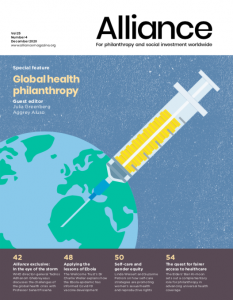Funders of health and medical research play a unique and important role. Beyond supporting individual projects and striving to achieve their purpose, funders can collectively influence culture and systems.
At the researcher level, emphasis is placed on what is measured and rewarded. For researchers, these are normally determined by their employers, but what if the business models and structures of the employer don’t align with the goals and purpose of the funder?
For many universities, success measurements revolve around revenue, traditional academic metrics and university rankings, as these are a primary marketing tool for attracting quality, fee-paying students. However, what if revenue and ranking systems don’t align with the goals and purpose of the funder?
If we examine the Times World University Rankings as an example, the weightings contributing towards the rankings are described as: research (volume, income and reputation): 30 per cent, citations (research influence): 30 per cent and industry income (knowledge transfer): 2.5 per cent.
If a funder’s purpose is to deliver community benefits, it becomes apparent that there is a divergence in thinking about the balance between traditional academic performance and research translation.
Opportunities for research translation often die at the bench. Research reaches a point where it needs to move beyond academia and silos. The need for researchers to maintain their careers, driven by the publish or perish paradigm, drives a focus towards ‘sexy’ research that will generate scientific headlines and be of high value to publishers.
This contributes towards what is often referred to as the ‘valley of death’. To cross the ‘valley of death’ and attract next-step partners, research often needs to be conducted by external researchers, laboratories and organisations. These activities may not be very interesting to publishers, are not conducted by the researcher’s own team and traditional funding systems may not support the activities required.
Crossing the ‘valley of death’ successfully also requires access to many non-research activities, and whilst funders support research, they are often unable to support these activities.
If a funder’s purpose is to deliver community benefits, it becomes apparent that there is a divergence in thinking about the balance between traditional academic performance and research translation.
Funders, however, can influence the culture and systems that will not only help their individual needs, but that of other funders.
At the National Foundation for Medical Research and Innovation (NFMRI), we have implemented a targeted strategy supporting pre-clinical research to cross the ‘valley of death’. Our support has assisted projects attract and secure next-step partners through spin-off companies and technology licensing, as well as to enter clinical trials. One of the more pleasing aspects is that our processes, systems and strategies are robust and reproducible irrespective of indication or innovation type (medicine, vaccine, device, diagnostic or tool).
Looking at more than the quality of research can make a difference.
Strategic fit
By taking a systems approach to our philanthropy we identified funding, cultural, knowledge, capability and capacity gaps that we could support to make a real difference. Sticking to a strategy and not being tempted to over-reach has been of significant benefit to the projects we support at NFMRI
Translational potential
This requires an understanding of the translational pathway and how the research outcomes will provide a community benefit.
- What is the unmet need?
- How important is the intervention (both size and impact)?
- Is there evidence to support a potential competitive advantage?
- What are the current interventions including those in development?
- Who may be the next-step partners?
- What is the intellectual property position?
- Are there any regulatory considerations? and
- Who will pay for it?
One key aspect is to consider the institution’s culture, willingness, capability and capacity to support research translation. Without this, no matter how good the research, it is unlikely to translate. NFMRI fails applications on their weakest link when considering translational potential.
Research activities
There is always an abundance of research activities, but how do the specific research studies contribute towards translation? Are the activities focused on advancing translation, attracting next-step partners and risk managed with a ‘kill-it-quick’ approach?
Should the studies be out-sourced to established research groups, do they need quality systems to ensure data usability and is there a real need for funding?
We look to encourage collaboration by supporting access to external capability and capacity to undertake key studies that are not normally supported by funders and potentially of lower academic value, but of high translational value. As a loose rule of thumb, researchers cannot spend their NFMRI grant in their own laboratories or institutions.
Measurement and reporting
We don’t believe in reporting and measurement for the sake of it. Our progressive online reporting platform focuses on what success looks like with regard to our strategy and translational outcomes. We try not to obfuscate measurement and communications with spill-over benefits.
Influence and support
Utilising our networks, grant recipients and mentors, we endeavour to assist researchers and their organisations navigate translational pathways. We have, at times, been able to influence institutional policy and have built strong networks between researchers. We regularly speak about translation with the goal of strengthening the ability of researchers and the system to better deliver community benefits from research.
Dr Noel Chambers is Chief Executive Officer of the National Foundation for Medical Research and Innovation.
Upcoming issue: Global health philanthropy
Subscribe today to make sure not to miss it!
At £46 billion each year – almost a quarter of all grantmaking – philanthropy spends more on health-related causes than anything else. As the Covid-19 pandemic intensified, philanthropy provided critical funding for vaccine development, medical equipment, mutual aid, social welfare, and global health infrastructure. But there is intense debate about how the largest foundations interact with governments, international bodies and pharmaceutical companies and how they should be held accountable to citizens. This issue of Alliance considers new directions for global health philanthropy and explores whether health funding is going where its most needed. It is guest edited by Julia Greenberg, Director, Governance and Financing, Public Health program, Open Society Foundations and Aggrey Aluso, Manager of Health and Rights Program, Open Society Initiative for Eastern Africa.






Comments (0)